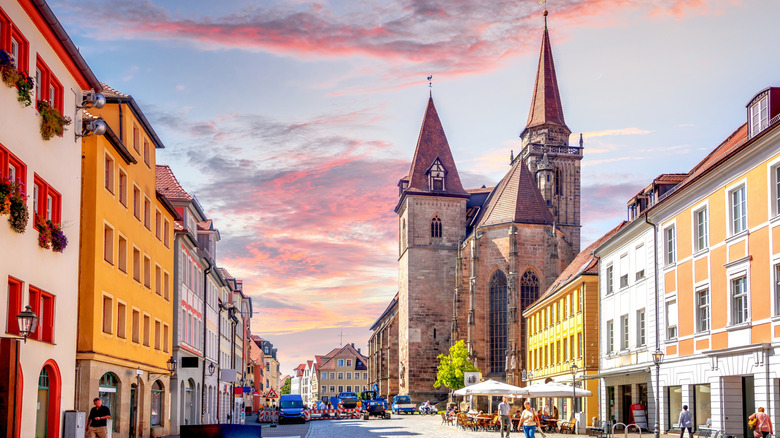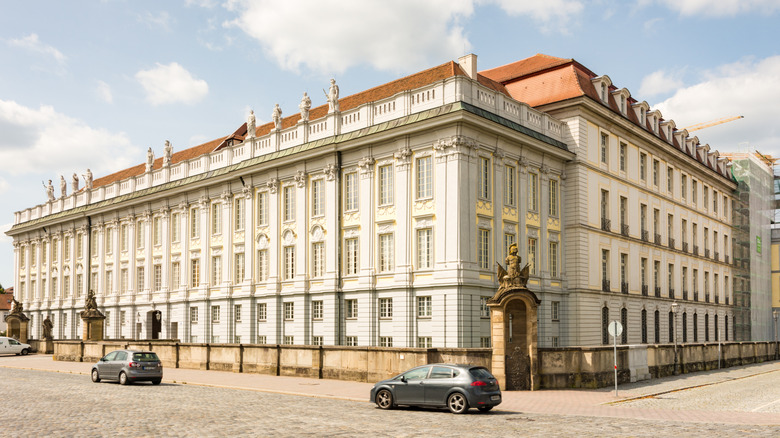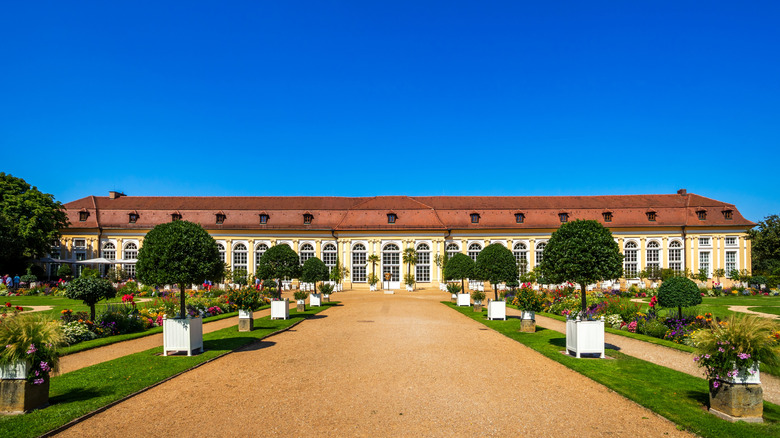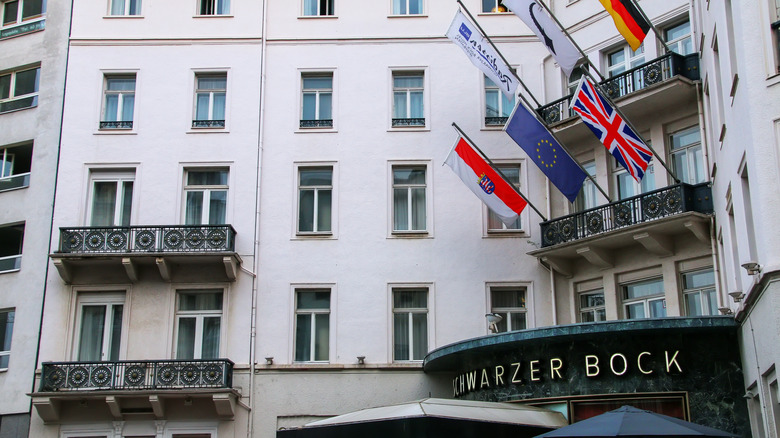Just Off Germany's Romantic Road Is A University City Known For Grand Palaces And Churches
As the second largest city in Bavaria and Germany's 14th largest city, Nuremberg has become quite the tourist attraction. The city has a distinctive style with its harmonious blend of contemporary design and historic landmarks dating back to medieval times, the pinnacle of which is the imposing Imperial Castle or Kaiserburg that overlooks the town. While not as opulent as Moritzburg Castle (a 16th-century hunting lodge turned fairytale palace), it gives a glimpse into medieval history. During the holiday season Nuremberg transforms into a cozy, quintessential fairytale land as its iconic Christkindlesmarkt ("Christmas market") springs up along the cobblestone streets. However, like Berlin with its fast-paced city life and thronging crowds, Nuremberg can become quite overwhelming with its estimated half a million inhabitants. Fortunately, there's another smaller, more remote destination roughly an hour's drive to the southwest that offers visitors an equally rich immersion into Bavaria's ancient culture.
Ansbach in southern Bavaria is located just off the Romantic Road, a famous German route conceptualized in the 1950s that was based on the past route that connected territories occupied by Rome. Similar to Trier, Germany's oldest city (and dotted with UNESCO sites), Ansbach has a vibrant and deeply rich history and stands as the administrative capital of Middle Franconia. With a population size of about 39,600, this often overlooked idyllic town is the perfect alternative to nearby bustling tourist attractions. Along with its more laid-back pace, Ansburg is home to some incredible sites, such as the Margrave Palace.
Ansbach used to seat the powerful ruling dynasty of Germany
While seemingly quaint and picturesque, Ansbach has quite the dynamic past. Dating back to the 8th century, Ansbach originally formed around a Benedictine monastery. Over time, the settlement grew into a vital epicenter of regional politics during the peak of the Holy Roman Empire, particularly in the 14th century when the independent margraviate was ruled by the Franconian branch of the Hohenzollern dynasty. A powerful family of kingmakers that eventually established the royal line that led to the crowning of Germany's first Emperor post-unification. The Hohenzollern dynasty was bifurcated into two specific groups — the Catholic-Swabian branch and Protestant-Franconian branch – the latter of which later formed the foundation for the kingdom of Prussia. The Franconian branch governed the region from Ansbach until it attained control of the Brandenburg territory and moved the capital to Berlin. The town was also the birthplace of the influential Queen Caroline in 1683, who later became queen consort to King George II of Great Britain.
During the 18th century, the then-ruling Margrave of Ansbach dispatched 2,500 soldiers to fight alongside the British Army during the American Revolution. Only 1,000 of these troops returned to the region after 400 were killed and the remainder opted to stay in the post-war colonies. Shortly after, the region fell into upheaval during the Napoleonic Wars and would not return to stability until the unification of Germanic territories in the 19th century. Today, Ansbach serves as a charming university town with the Ansbach University of Applied Sciences at its epicenter. Incidentally, since World War II, it also functions as a longstanding host to a U.S. Army garrison.
Tour the opulent grounds of the magnificent Margrave Palace
Ansbach may be less well-known, but it certainly packs quite the itinerary of places to visit. Unlike the quintessential half-timbered, thatch-work buildings seen in neighboring German cities like Rothenburg ob der Tauber (one of Rick Steve's favorites, even though people think it's a tourist trap) or Nuremberg, Ansbach stands out with its atypical Baroque architecture. A good example of this is the impressive Margrave's Palace ("Markgrafenschloß"), a grand building constructed with elements of the Renaissance style to serve as the permanent residence for the Margrave of Brandenburg-Ansbach and the royal family. In modern times, the palatial building not only seats the administrative government of Middle Franconia, but also hosts the summer Rococo Festival where people don vibrant period costumes, engage in fun activities, and listen to baroque-style classical music. For another serious dose of history and architecture, visit St. Gumbertus, a towering church that has become emblematic of the town. With some luck, you might also get to hear the newly restored Baroque organ play.
Swing by the Markgrafen Museum (opening hours are 10 a.m. to 5 p.m.) to experience a deep dive into local lore, especially surrounding the enigmatic figure of Kaspar Hauser, an orphan teen in 1828 who did not know much about his past except claiming to have been raised in a dark cell. His birth and subsequent fatal stabbing sparked a torrent of speculation rivaling the legacy of Jack the Ripper as to his mysterious identity. If you're an animal lover, consider a tour of the Raubtier- und Exotenasyl if your visit coincides with their open day (the first Sunday of every month). Originally formed as a rehabilitation center for wild cats, the organization now accommodates an array of exotic, abandoned, and ill-treated animals.
For as little as $75 per night you can stay in a tranquil German inn
Hotel accommodations are plentiful in Ansbach and within easy commuting distance of nearby attractions. In the heart of the city stands Hotel Schwarzer Bock, a well-renowned guesthouse that has housed visitors since the Middle Ages. Guests stay in contemporary-style rooms while sampling from a variety of savory, traditional Bavarian dishes at an in-house restaurant. After dinner, make sure you don't miss out on the highly acclaimed Ansbach gingerbread for dessert, which is baked using a recipe of spices and ingredients that extends back generations. However, reservations at this historic hostelry tend to land more on the expensive side with costs averaging around $200 per night. While slightly away from the city center, Hotel Platengarten is an elegant, privately owned inn located directly across from Margrave's Palace. After their breakfast, guests can take a leisurely morning stroll through the castle's intricate Rococo-designed gardens and orangery. If you're looking for more economic housing, the cheap and charming Hotel Gasthof Käßer is located in the nearby hamlet of Brodswinden where you can reserve a cozy room for about $75 a night.
For travelers looking for a German experience beyond the normal tourist routes, Ansbach is a beautiful alternative that encapsulates the authentic side of Bavarian culture and history. Whether you're passionate about the past or a die-hard foodie, this hidden gem of a community has plenty to offer. From the scenic castles and churches to the delicious cuisine you'll be wanting to extend your trip far longer than planned.



